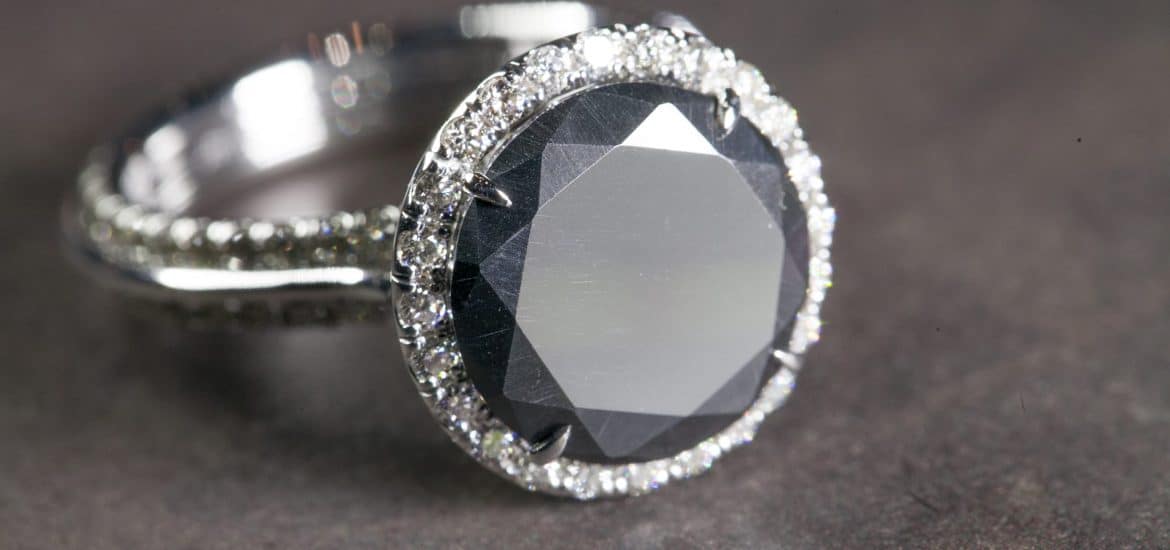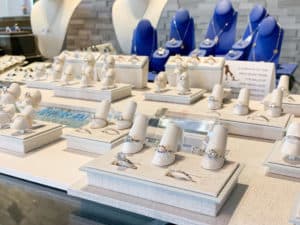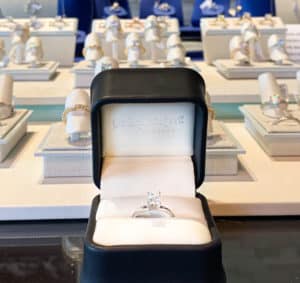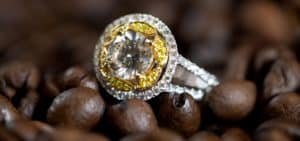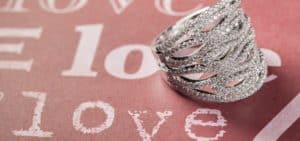For those that wear jewelry regularly, keeping their jewelry clean and looking good requires regular effort. Here are some general guidelines that may help: Clean Your Jewelry With Care
Cleaning your own jewelry regularly can keep it looking good, but be careful.
You can either purchase commercial cleaners from a jeweler or make a cleaning a solution yourself. Rubbing alcohol can work wonders, but bleach can literally destroy jewelry so avoid it at all costs.
Use Warm Water to Clean Jewelry
Using warm water is the best bet when cleaning your own jewelry. However, water can cause reaction with the cleaning fluids resulting in discoloration and Sterling Silver is especially susceptible to this problem. Should this occur, this problem can be remedied by buffing with a treated polish cloth or the application of a tarnish remover.
Diamonds
Lotions, powders, soaps, even natural skin oils, put a film on diamonds and cut down their brilliance.
Diamonds are durable, so they can be scrubbed and buffed with a little less caution than other gemstones.
Clean your diamond jewelry regularly at home in an ultrasonic cleaner or by hand. To make your own jewelry cleaning solution, mix one part of ammonia to six parts water.
Gently scrub the diamond piece with a small soft toothbrush to loosen dirt and restore the diamond’s brilliance. Be careful not to scratch the metal setting. Always rinse after cleaning.
Rubies and Sapphires
To clean rubies and sapphire jewelry at home, use a lukewarm solution of water and mild dishwashing soap, or one part ammonia to six parts water. Keep your gems brilliant by gently brushing them with a small bristle brush, especially underneath where dirt collects. Rinse and dry.
Pearls
Pearls can keep their luster for a very long time, when cared for. Proper pearl care is not difficult, as long as you remember that these gems are organic by nature, grown in water from living cells of a living creature.
The best way to help your pearls maintain their luster is to wear them regularly. Your own body’s natural oils, aid in maintaining the pearls’ beauty.
Pearls should be worn alone. If worn with other jewelry, such as a gold chain or other necklace, they may be scratched or damaged.
Apply any cosmetics, lotions, perfume or hair spray before putting on your pearls. Make your pearls the last item you put on when getting dressed and the first item you take off.
Avoid contact with salt water, chlorinated water, or perspiration.
Wipe your pearls after wearing them, using a soft cloth.
Remove spills immediately when pearls come in contact with any foods or liquids. Wipe them with a soft damp cloth and then with a dry soft cloth.
Store your pearls separately from other jewelry, preferably in a cloth bag. Storing them in a slightly damp linen cloth will help the pearls from drying out in low humidity atmospheres and centrally heated areas.
Never clean your pearls with soap, detergents, or jewelry cleaner. A harsh cleanser can wear away the nacre.
Never use an ultrasonic jewelry cleaning machine or steam cleaner.
Have your pearls restrung every two to five years if worn regularly, or when the silk becomes dirty. Take your pearls to a professional jeweler for cleaning prior to restringing, which will add to the beauty and long life of your pearls.
Gold Jewelry
Proper care of your gold jewelry will assure a long-lasting glow. Gold jewelry can tarnishsince a large portion of all solid gold jewelry on the market contains some type of alloy with the exception of 24k (pure gold). The alloys used in gold jewelry may tarnish. Not only that, gold jewelry collects dirt and grime and loses it’s luster over time.
Every so often, clean your gold jewelry with a mild detergent or ammonia solution (one part ammonia to six parts water). Avoid ammonia solution when cleaning pieces that contain pearls.
Grease can be removed from karat gold jewelry by dipping the jewelry into plain rubbing alcohol. Check with your jeweler about colored gemstone pieces.
Do not use any kind of abrasive that might scratch the gold such as baking soda and toothpaste.
Use a soft brush to gently clean intricate filigree designs and under gemstones.
Rinse and wipe jewelry after cleaning.Avoid use of tissue or paper towel, fibers in these products can cause scratches.
Platinum Jewelry
Like gold, platinum jewelry does not tarnish.
Simply clean your platinum pieces with a soft cloth and mild detergent or ammonia solution (one part ammonia to six parts water) to maintain their luster.
Use of tissue or paper towels can cause scratches because of fibers in these products.
Silver Jewelry
Sterling silver by nature may tarnish when it is not worn. To maintain the luster of your jewelry, place silver anti-tarnish strips in your storage container to absorb the oxidants that discolor and tarnish the metal.
Use a treated professional cleaning and polishing cloth will restore luster without scratching or removing the finish. This cloth can also be used on your gold and platinum jewelry.
Alternatively, create your own cleaning solution. Baking soda is an abrasive that you won’t want to use on gold, but since silver is less expensive and a harder metal, you are much less likely to scratch it.
What You’ll Need:Aluminum FoilAluminum or glass dish/pan with rimmed edge1 cup Boiling Water1/2 cup Vinegar1 tablespoon Baking Soda1 tablespoon SaltSoft cloth or microfiber clothTongs/tweezers
Directions:
Line the bottom of your pan or dish with aluminum foil. Mix salt and baking soda together in pan. SLOWLY pour the vinegar into the pan. There will be a reaction between the baking soda and the vinegar, so use caution. Then slowly add the boiling water to the mixture. Drop your jewelry into the solution, making sure all jewelry is touching the aluminum foil and isn’t overlapping one another. Let the jewelry sit for 30 seconds to 3 minutes depending on how tarnished your jewelry is.
When you notice that the metal has become bright again, remove the jewelry and rinse under the tap. Wipe gently with a towel and polish with a soft cloth. Use of tissue or paper towels can cause scratches because of fibers in these products.
Tip: If your dish is really large or you have a lot of jewelry, you may need to double or triple the recipe. You want it so that all of your jewelry is completely submerged in the solution.
*Note that this method should only be used if your jewelry does not contain gemstones as the saltwater could damage the settings.

